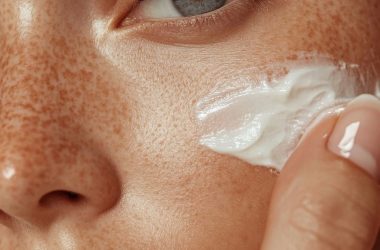The Shocking Truth About Popular Skincare Habits That Could Be Making Your Pores Look Bigger (And the Simple Fixes That Actually Work)
Posted on June 18, 2025 Written by: 100% PURE®

Your daily skincare routine might be sabotaging your pores without you realizing it. While you’re diligently following the steps for a skincare routine you’ve read about online, some of these well-intentioned habits could actually be making your pores appear larger, more clogged, and more noticeable. Here’s the surprising truth about what’s really happening to your pores—and the simple changes that can transform your skin.
The Pore Reality Check: What’s Actually Happening to Your Skin
Every day, millions of people look in the mirror and wonder why their pores seem more noticeable than ever, despite following elaborate skincare routines and using expensive products. The frustration is real: you’re doing everything “right” according to beauty influencers and skincare guides, yet your pores look larger, more congested, or more prominent than when you started.
The shocking truth is that many popular skincare practices—from over-cleansing to aggressive exfoliation to using the wrong products for your skin type—can actually make pore-related concerns worse rather than better. What’s marketed as “pore-minimizing” or “deep-cleaning” often disrupts your skin’s natural balance in ways that backfire spectacularly.
Understanding what’s really happening requires separating skincare myths from scientific reality. Pores can’t actually shrink or expand like muscles, but they can appear larger or smaller based on how clogged they are, how much oil your skin produces, and how the surrounding skin tissue behaves. Many common skincare mistakes affect these factors in negative ways.
The beauty industry profits from pore anxiety, promoting increasingly aggressive treatments and complex routines that promise dramatic results. However, the skin’s natural processes work best when supported gently and consistently, not when overwhelmed with harsh interventions that disrupt its delicate balance.
What’s particularly frustrating is that the steps for a skincare routine that actually improve pore appearance are often simpler and gentler than the aggressive approaches that dominate social media. The most effective pore care involves working with your skin’s natural functions rather than fighting against them.
The good news is that once you understand what’s really happening and make targeted adjustments to your routine, you can see significant improvements in pore appearance within weeks. The key is identifying which of your current habits might be counterproductive and replacing them with science-backed alternatives that actually work.
Step 1: Over-Cleansing Is Stretching Your Pores
The first shocking revelation about modern skincare routines is how over-cleansing—one of the most common mistakes—can actually make pores appear larger and more problematic over time. The “squeaky clean” feeling that many people chase is often a sign that you’ve stripped your skin’s protective barrier and triggered a cascade of pore-enlarging problems.
The Over-Cleansing Trap Many people believe that more cleansing equals cleaner pores, leading to double cleansing morning and night, using harsh foaming cleansers, or scrubbing aggressively to achieve that tight, clean feeling. This approach backfires because it strips away your skin’s natural oils, triggering increased oil production that can actually make pores appear larger and more clogged.
When you over-cleanse, your skin interprets the aggressive removal of oils as a threat and responds by producing even more sebum to protect itself. This rebound oil production often exceeds your skin’s normal levels, leading to more congested pores and a shinier appearance that makes pores more visible.
The Mechanical Damage Factor Harsh scrubbing, rough washcloths, and abrasive cleansing tools can create micro-damage around pore openings, causing inflammation that makes pores appear larger temporarily and can lead to permanent enlargement over time. The delicate tissue around pores is particularly susceptible to this type of mechanical damage.
The Right Way to Cleanse for Pore Health The best natural face cleanser for pore health is one that removes impurities without stripping natural oils or causing irritation. The Rose Water Gentle Cleanser exemplifies this approach, providing effective cleansing while maintaining skin balance and supporting the natural moisture barrier.
This gentle formulation removes makeup, sunscreen, and daily impurities without the harsh sulfates that can disrupt skin pH and trigger increased oil production. The rose water component provides additional benefits by offering light hydration and anti-inflammatory properties that support healthy pore function.
For those with sensitive or reactive skin, the Lavender Oat Milk Soothing Cleanser provides even gentler cleansing with calming ingredients that reduce inflammation around pores. The oat milk component offers natural saponins for gentle cleansing while the lavender soothes irritated skin that might be contributing to pore visibility.
Optimal Cleansing Frequency and Technique Contrary to popular belief, most people only need to cleanse with a dedicated cleanser once per day, typically in the evening to remove the day’s accumulation of sunscreen, makeup, and environmental pollutants. Morning cleansing can often be accomplished with just water or a very gentle rinse, unless you’ve used heavy nighttime treatments.
Use lukewarm water rather than hot water, which can strip oils and cause inflammation that makes pores more visible. Apply cleanser with gentle circular motions using only your fingertips, avoiding any scrubbing or aggressive pressure that could irritate pore openings.
The goal is to remove impurities while preserving your skin’s natural protective functions, creating an environment where pores can function optimally without becoming congested or inflamed.

Step 2: Aggressive Exfoliation Is Creating Micro-Damage
The second major skincare mistake that’s affecting your pores is aggressive or overly frequent exfoliation. While gentle exfoliation can help remove dead skin cells that might clog pores, the harsh scrubs and daily acid treatments that many people use actually create inflammation and damage that makes pores appear larger and more problematic.
The Exfoliation Addiction Problem Social media has created an exfoliation obsession, with people using multiple exfoliating products daily or combining physical and chemical exfoliants in ways that severely compromise the skin barrier. This over-exfoliation strips away the protective layer of skin cells, leaving pores more exposed and vulnerable to damage.
When you remove too much of the skin’s protective layer, sebaceous filaments—the natural, hair-like structures that line pores—become more visible and are often mistaken for blackheads. This leads to even more aggressive treatment, creating a cycle of damage and increased pore visibility.
The Inflammation-Pore Size Connection Aggressive exfoliation causes chronic low-level inflammation around pore openings, which can make them appear larger both temporarily and permanently. Inflamed tissue swells, making pores more prominent, while repeated inflammation can damage the supportive collagen around pores, leading to permanent enlargement.
The micro-tears created by harsh physical exfoliants provide entry points for bacteria and irritants, potentially leading to breakouts that further stretch pore openings and create lasting damage to pore structure.
Smart Exfoliation for Pore Health The Acai Facial Pulp Scrub represents the ideal approach to pore-friendly exfoliation. This gentle physical exfoliant uses fruit acids and fine particles to remove dead skin cells without creating the micro-damage that harsh scrubs cause.
The acai component provides antioxidants that support skin healing while the gentle exfoliating action helps prevent the buildup of dead skin cells that can make pores appear clogged or enlarged. The formulation is designed to work with your skin’s natural renewal process rather than forcing it.
Proper Exfoliation Frequency and Technique Most skin types benefit from exfoliation only 1-2 times per week, regardless of the method used. More frequent exfoliation typically causes more harm than benefit, disrupting the skin barrier and triggering the inflammatory responses that make pores more visible.
When using the Acai Facial Pulp Scrub, apply to damp skin with gentle circular motions, focusing on areas where dead skin buildup is most noticeable. Avoid the delicate eye area and don’t apply additional pressure—let the product do the work.
Follow exfoliation immediately with hydrating and soothing products to support skin recovery and minimize any potential irritation that could affect pore appearance.
Signs You’re Over-Exfoliating Watch for increased skin sensitivity, persistent redness, more visible sebaceous filaments, increased breakouts, or a feeling that your skin is never quite “clean” enough. These signs indicate that your exfoliation routine is working against your pore health rather than supporting it.
Step 3: Skipping Toner Is Leaving Your Pores Vulnerable
The third surprising way your routine might be affecting your pores is through toner mistakes—either skipping this crucial step entirely or using the wrong type of toner for your skin’s needs. Modern toners serve important functions in pore health that many people don’t understand, leading to missed opportunities for improvement.
The Toner Misconception Many people skip toner because they associate it with the harsh, alcohol-based astringents of the past that dried out skin and caused irritation. However, modern toners like the Flower Water Toner serve completely different functions, focusing on pH balance, hydration, and preparation for subsequent products rather than stripping oils.
Without proper toning, your skin’s pH can remain elevated after cleansing, creating an environment where pores are more likely to become clogged and appear larger. The alkaline environment left by many cleansers can also affect how well your other skincare products absorb and function.
The pH-Pore Connection Your skin’s natural pH is slightly acidic, around 5.5, which helps maintain the acid mantle that protects against bacteria and regulates oil production. When cleansing disrupts this pH balance, pores can become more susceptible to congestion and inflammation.
A properly formulated toner helps restore optimal pH quickly, creating conditions where pores can function normally and other skincare products can work more effectively. This pH restoration is particularly important for maintaining healthy sebum production that doesn’t overwhelm pores.
How the Right Toner Supports Pore Health The Flower Water Toner provides multiple pore-supporting benefits beyond pH restoration. The floral waters offer gentle hydration that helps maintain skin barrier function, while the light formulation prepares skin to better absorb serums and moisturizers that support pore health.
This type of hydrating toner also helps regulate oil production by ensuring skin doesn’t become dehydrated—a condition that often triggers increased sebum production as the skin tries to compensate for moisture loss.
Proper Toner Application for Maximum Benefit Apply toner to clean skin using gentle patting motions with your hands or a soft cotton pad. Avoid harsh wiping or rubbing that could irritate skin and affect pore appearance. The goal is to distribute the product evenly while allowing it to absorb completely.
Allow toner to dry completely before applying subsequent products. This ensures optimal pH restoration and prevents product interactions that could affect the performance of your serums or moisturizers.
Choosing the Right Toner Type Avoid toners with high alcohol content, harsh acids, or strong fragrances that can irritate skin and worsen pore appearance. Instead, choose hydrating, pH-balancing formulations like the Flower Water Toner that support skin function rather than disrupting it.
For those with very oily skin, a gently clarifying toner can help manage excess sebum without the harsh drying effects that often backfire by triggering increased oil production.
Step 4: Using the Wrong Serums Is Clogging Your Pores
The fourth shocking way your skincare routine might be affecting your pores involves serum selection and application. Many people choose serums based on marketing claims rather than understanding how different ingredients interact with their skin type, leading to clogged pores, increased congestion, and more visible pore appearance.
The Heavy Serum Trap One of the most common mistakes is using serums that are too heavy or occlusive for your skin type, particularly in areas prone to congestion. Thick, oil-based serums can overwhelm pores that are already producing adequate sebum, leading to backup and more visible congestion.
Many people also layer multiple serums without understanding how the ingredients interact or how the combined weight affects pore function. This “more is better” approach often backfires by creating a barrier that prevents natural skin processes from working effectively.
The Wrong Active Ingredients Problem Some popular serum ingredients, while beneficial for certain skin concerns, can actually worsen pore appearance if used incorrectly. High concentrations of certain oils, for example, can feed the bacteria that contribute to pore congestion, while some acids can cause irritation that makes pores appear larger.
The Right Serum Approach for Pore Health The Vitamin C Serum represents an ideal choice for pore health because it provides multiple benefits without the heaviness or pore-clogging potential of many other formulations. Vitamin C supports collagen production around pores, helping maintain the structural integrity that keeps pores looking smaller and tighter.
The antioxidant properties of vitamin C also help prevent the oxidative damage that can affect pore structure over time, while the brightening effects help minimize the shadowing that makes pores appear darker and more prominent.
How Vitamin C Serum Benefits Pore Appearance Beyond the structural support, vitamin c serum helps regulate sebum oxidation—the process that can make pore contents appear darker and more noticeable. By preventing this oxidation, vitamin C helps keep sebaceous filaments less visible and prevents the formation of true blackheads.
The gentle nature of a well-formulated vitamin C serum also means it’s less likely to cause the irritation that can make pores appear inflamed and enlarged. This makes it suitable for daily use without the cycling of improvement and worsening that some harsher actives create.
Proper Serum Application for Pore Health Apply Vitamin C Serum to clean, toned skin using gentle patting motions. Start with a small amount and allow complete absorption before applying additional products. The goal is to deliver active ingredients without overwhelming pores with too much product.
Use vitamin C serum in the morning to provide antioxidant protection throughout the day, when your skin is most exposed to environmental factors that can affect pore health and appearance.
Avoiding Serum Mistakes Don’t layer multiple active serums without understanding their interactions, avoid using amounts that exceed what your skin can absorb, and pay attention to how your skin responds to different formulations. Some people need lighter, water-based serums while others can handle more emollient formulations.
Watch for signs that your serum is too heavy for your skin: increased breakouts, more visible sebaceous filaments, or a feeling that your skin never feels “clean” despite proper cleansing.
Step 5: Over-Moisturizing Is Suffocating Your Pores
The fifth and perhaps most surprising way your skincare routine might be affecting your pores is through moisturizer mistakes. Many people either skip moisturizer entirely (thinking it will clog pores) or use formulations that are too heavy for their skin type, both of which can actually make pores appear larger and more problematic.
The Moisturizer Avoidance Mistake Many people with visible pores avoid moisturizer, thinking it will make their skin oilier or clog their pores further. This approach backfires because dehydrated skin actually triggers increased oil production as the skin tries to compensate for moisture loss, leading to more congested and visible pores.
Without adequate moisture, the skin around pores can also become less plump and firm, making pores appear larger due to loss of surrounding structural support.
The Heavy Moisturizer Problem On the opposite end, using moisturizers that are too heavy or occlusive can overwhelm pores and prevent normal sebum flow, leading to backup and congestion that makes pores more visible. This is particularly problematic for people with naturally oily skin who choose rich creams thinking they need “intense hydration.”
The Perfect Balance for Pore Health The Coffee Bean Caffeine Restorative Moisturizer provides an excellent example of pore-friendly moisturizing. The caffeine component helps improve circulation around pores, which can help with the natural clearing process, while the lightweight formulation provides essential hydration without overwhelming pore function.
Caffeine also has mild astringent properties that can help temporarily tighten the appearance of pores without the harsh drying effects of traditional astringents that often trigger rebound oil production.
How Proper Moisturizing Supports Pore Health The right moisturizer helps maintain the skin barrier function that’s essential for healthy pore operation. When the skin barrier is compromised, pores can become more susceptible to congestion and inflammation that makes them appear larger.
Adequate moisturization also helps regulate oil production by ensuring the skin doesn’t become dehydrated and trigger increased sebum production as compensation. This balanced oil production is key to preventing the pore congestion that makes them more visible.
Choosing the Right Moisturizer Texture For most people concerned about pore appearance, lightweight, fast-absorbing moisturizers work better than heavy creams. The Coffee Bean Caffeine Restorative Moisturizer provides substantial hydration in a texture that won’t overwhelm pores or create the heavy feeling that some people associate with moisturizer.
Look for formulations that absorb completely within a few minutes of application and don’t leave a greasy or heavy residue that could interfere with normal pore function.
Application Technique for Pore-Prone Skin Apply moisturizer with gentle upward motions, using only the amount needed to cover your face without creating a heavy layer. Pay attention to how much your skin absorbs—if product sits on the surface for more than a few minutes, you’re likely using too much or a formulation that’s too heavy.
Focus on providing hydration to the skin around pores rather than trying to “fill” pores with product, which can actually make them appear more prominent.

The Hidden Impact of Sebaceous Filaments on Pore Appearance
Understanding sebaceous filaments—those grayish, hair-like structures that naturally exist in pores—is crucial for making sense of why certain skincare steps might be making your pores look worse rather than better. Many people mistake these natural structures for blackheads and treat them aggressively, creating inflammation and damage that actually makes pores appear larger.
What Sebaceous Filaments Really Are Sebaceous filaments are normal, functional parts of your pore structure that help transport oil from deep within the pore to the skin’s surface. Everyone has them, and they serve important protective functions by helping maintain skin hydration and providing antimicrobial protection.
These filaments become more visible when pores are larger, when oil production is high, or when the surrounding skin lacks firmness. They’re not blockages that need to be removed—they’re working components of healthy skin that will immediately reform if extracted.
Why Aggressive Treatment Backfires When people try to remove sebaceous filaments through aggressive extraction, harsh scrubs, or strong acids, they often create inflammation and damage that makes the filaments more visible, not less. The trauma from aggressive treatment can also stretch pore openings, making filaments permanently more noticeable.
The cycle of extraction and reformation also means that aggressive treatment provides only temporary results while potentially causing lasting damage to pore structure and surrounding skin.
How to Make Sebaceous Filaments Less Visible The key to minimizing sebaceous filament visibility is maintaining healthy pore function through gentle, consistent care rather than aggressive intervention. This means using the right combination of gentle cleansing, appropriate exfoliation, and products that support rather than disrupt normal skin function.
The Vitamin C Serum helps in this process by supporting collagen production around pores, which can help maintain the structural integrity that keeps filaments less visible. The antioxidant properties also help prevent oxidation that can make filaments appear darker.
Regular use of gentle exfoliation with the Acai Facial Pulp Scrub helps prevent the buildup of dead skin cells that can make filaments more prominent, while the Coffee Bean Caffeine Restorative Moisturizer supports circulation that aids in natural pore clearing processes.
How to Make Pores Smaller: The Science-Backed Approach
While you can’t actually change the size of your pores permanently, understanding how to make pores smaller in appearance involves supporting the factors that affect their visibility: oil production, surrounding skin firmness, and the clarity of pore contents.
The Collagen Connection Pore size appearance is significantly affected by the firmness and thickness of surrounding skin tissue. As collagen production decreases with age or is damaged by environmental factors, the skin around pores becomes less supportive, making pores appear larger.
Supporting collagen production through ingredients like vitamin C helps maintain the structural framework around pores. The Vitamin C Serum provides this support while also offering antioxidant protection against further collagen damage.
Oil Production Regulation Balanced oil production is crucial for pore appearance. Too little oil can make skin around pores look sunken and emphasize their appearance, while too much oil can cause congestion that stretches pore openings.
The gentle, balanced approach of using the Rose Water Gentle Cleanser or Lavender Oat Milk Soothing Cleanser helps maintain natural oil production without triggering the rebound effects that harsher cleansers often cause.
Inflammation Reduction Chronic inflammation around pores can make them appear larger both temporarily and permanently. Gentle skincare practices that avoid irritation help maintain normal pore appearance by preventing inflammatory responses.
The anti-inflammatory properties found in products like the Flower Water Toner and Coffee Bean Caffeine Restorative Moisturizer help soothe skin and reduce the inflammation that can make pores more prominent.
Consistent, Gentle Care The most effective approach to improving pore appearance involves consistent, gentle care that supports natural skin function rather than aggressive interventions that disrupt it. This means choosing the right products for your skin type and using them consistently over time.
The combination of proper cleansing, gentle exfoliation, appropriate hydration, and targeted active ingredients provides comprehensive support for pore health without the inflammatory side effects of harsher approaches.
Building Your Pore-Friendly Routine
Creating an effective routine for pore health requires understanding your specific skin type and concerns while avoiding the common mistakes that can make pores appear larger or more problematic.
Morning Routine for Pore Health Start with gentle cleansing using the Rose Water Gentle Cleanser if you need full cleansing, or simply rinse with lukewarm water if your skin doesn’t require morning cleansing. Follow with Flower Water Toner to restore pH balance and prepare skin for treatment products.
Apply Vitamin C Serum for antioxidant protection and collagen support, allowing complete absorption before applying Coffee Bean Caffeine Restorative Moisturizer for hydration and circulation support. Finish with broad-spectrum sunscreen to prevent the UV damage that can affect pore structure over time.
Evening Routine for Pore Support Evening routines can be slightly more intensive, as this is when skin focuses on repair and renewal. Begin with thorough cleansing using your chosen gentle cleanser to remove the day’s accumulation of sunscreen, makeup, and environmental pollutants.
Follow with Flower Water Toner, then Vitamin C Serum if you prefer evening application, or alternate with other treatment products based on your skin’s needs. Finish with appropriate moisturization using theCoffee Bean Caffeine Restorative Moisturizer
Weekly Treatments Incorporate gentle exfoliation with the Acai Facial Pulp Scrub 1-2 times per week, adjusting frequency based on your skin’s response. More frequent exfoliation typically provides diminishing returns and can actually worsen pore appearance through over-stimulation.
Customizing for Your Skin Type Adjust product amounts and frequency based on your skin’s oil production, sensitivity level, and current condition. Those with naturally oily skin might need slightly more frequent cleansing or exfoliation, while sensitive skin types should err on the side of gentleness.
Patience and Consistency Improving pore appearance takes time—typically 6-8 weeks of consistent, appropriate care to see significant changes. Resist the urge to add aggressive treatments if you don’t see immediate results, as consistency with gentle care typically provides better long-term outcomes.
Conclusion: The Truth About Pore-Perfect Skin
The journey to better-looking pores isn’t about aggressive treatments or complex routines—it’s about understanding what your skin actually needs and avoiding the common mistakes that make pores appear larger and more problematic. The shocking truth is that gentler approaches often provide better results than the harsh treatments that dominate social media skincare culture.
Your pores are not your enemy, and the goal shouldn’t be to eliminate or dramatically shrink them, but rather to support their healthy function while minimizing their appearance through smart, science-backed skincare practices. The steps for a skincare routine that actually improve pore health focus on balance, gentleness, and consistency rather than aggressive intervention.
Products like the Rose Water Gentle Cleanser, Vitamin C Serum, Flower Water Toner, Acai Facial Pulp Scrub, and Coffee Bean Caffeine Restorative Moisturizer work together to support healthy pore function without the inflammatory side effects that make pores more visible. The best natural face cleanser and supporting products work with your skin’s natural processes rather than against them.
Understanding sebaceous filaments and how to make pores smaller in appearance requires patience and a willingness to abandon the quick-fix mentality that often leads to skin damage. Real improvement comes from consistent, appropriate care that supports skin health rather than aggressive treatments that provide temporary results at the cost of long-term damage.
Remember that everyone has pores, and even people with seemingly perfect skin have sebaceous filaments and natural skin texture. The goal is healthy, balanced skin where pores can function optimally without becoming inflamed, congested, or unnecessarily prominent.
Your skincare routine should support your skin’s natural beauty rather than fighting against it. By avoiding the common mistakes that make pores worse and embracing gentle, effective care, you can achieve the clear, smooth-looking skin that comes from truly healthy pores.
Frequently Asked Questions
Can I actually make my pores smaller permanently? You cannot permanently change your genetic pore size, but you can significantly improve their appearance through proper skincare. Supporting collagen production with Vitamin C Serum, maintaining clean pores with gentle cleansing, and keeping skin properly hydrated all help pores appear smaller and less noticeable.
How often should I exfoliate to improve pore appearance? Most people should exfoliate only 1-2 times per week with a gentle product like Acai Facial Pulp Scrub. More frequent exfoliation often backfires by causing inflammation that makes pores appear larger. Pay attention to your skin’s response and adjust frequency accordingly.
What’s the difference between sebaceous filaments and blackheads? Sebaceous filaments are natural, grayish structures that help transport oil through pores and are present in everyone’s skin. Blackheads are actual blockages of oxidized oil and debris. Filaments will immediately reform if extracted, while properly treated blackheads won’t return immediately to the same pore.
Why do my pores look bigger after I started a new skincare routine? New routines can initially cause purging or adjustment reactions that temporarily make pores appear more prominent. However, if pores look consistently worse after 4-6 weeks, you may be using products that are too harsh or inappropriate for your skin type. Consider switching to gentler options like the Rose Water Gentle Cleanser.
Should I use different products for different areas of my face? While the basic steps for a skincare routine remain consistent, you can adjust application amounts based on different areas’ needs. Your T-zone might need slightly more frequent cleansing or exfoliation, while sensitive areas around the eyes need gentler treatment.
How long does it take to see improvement in pore appearance? With consistent, appropriate care using products like Vitamin C Serum and Coffee Bean Caffeine Restorative Moisturizer , most people see gradual improvement over 6-8 weeks. However, dramatic changes aren’t realistic—the goal is healthier-functioning pores that appear less prominent over time.









